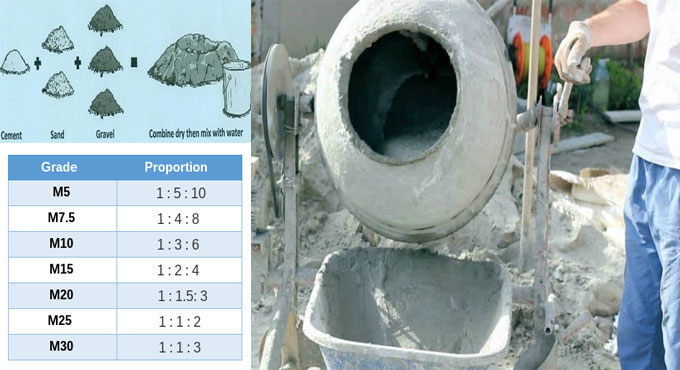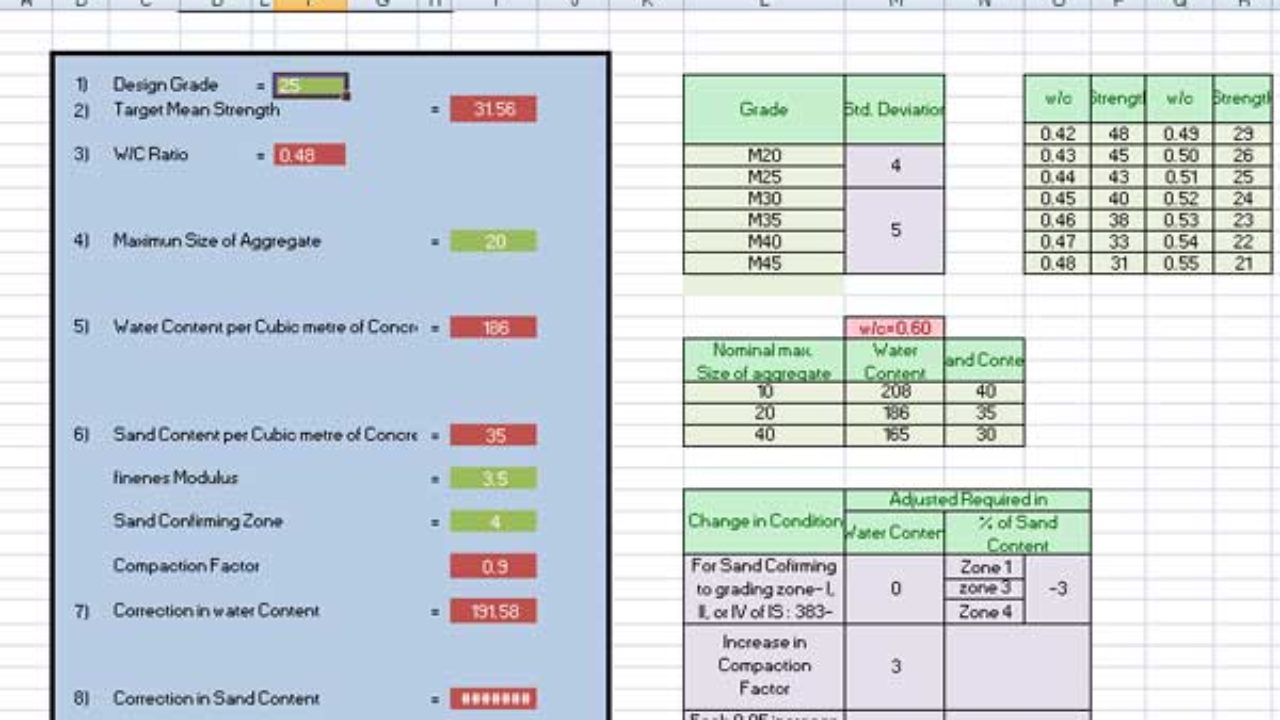Concrete Mix Design Concrete Mix Steps and Design Calculation
Table Of Content

Additionally, creating mixed designs can be tailored to meet specific needs, such as strength requirements or environmental considerations. For example, M45, cement volume, sand (fine aggregate), and coarse aggregate are batched in quantities according to the design mix. Calculations require an in-depth understanding of the factors that influence concrete mix design and can often be complex. Utilizing industry-standard software tools can simplify the calculation process and provide detailed reports on properties such as compressive strength, workability, and durability. Concrete mix design standards and codes provide guidelines to ensure quality and consistency in the mix design process.
How to Estimate Duration of Activities in Construction
Overlooking factors like material quality, incorrect water-cement ratio, or inadequate testing can compromise the performance of concrete. Each of these methods has its unique approach and considerations, and the choice of method depends on factors like project specifications, local standards, and available resources. Engineers and concrete technologists select the most appropriate method to design concrete mixes that meet the specific requirements of each construction project. Concrete is one of the most fundamental building materials, used extensively in construction projects worldwide. The success of any construction project heavily relies on the quality and durability of the concrete used. Concrete mix design plays a crucial role in achieving the desired properties and performance of concrete.
Percentage strength of concrete at various ages
However, the designed combination does not function information because it doesn’t guarantee the correct mixing ratio for the prescribed efficiency. Concrete homes feature exceptionally solid, energy-efficient concrete construction that provides comfortable shelter in all seasons due to the tighter building envelope. Concrete walls are also favored in areas that experience hurricanes and other natural disasters because they can minimize property damage and protect occupants under extreme conditions.
What is the tolerance for compression test results of concrete, according to the standards?
The mix design should also be adjusted to suit any changes in the project or environmental conditions. To better understand the process of concrete mix design, let’s walk through an example. Consider a project that requires a concrete mix with a compressive strength of 4000 psi and a workability of 4 inches. We will use the ACI mix design method discussed in Section 8 to design the mix proportions. Overall, the advantages of nominal mix concrete over design mix concrete make it an excellent option for specific needs and use cases.
What is Design Mix Concrete?
The use of the correct mix ratio provides the desired level of strength and durability. The weight specification of individual components also helps to ensure that the concrete is mixed correctly, reducing risk to the project. By creating the right mix design and ensuring that all components are accurately proportioned and blended, contractors can ensure that the concrete produced is of the highest quality. This helps to ensure that construction projects are completed according to the highest standards. The American Concrete Institute (ACI) has developed a widely accepted concrete mix design method to ensure uniformity and quality of concrete. The ACI method involves determining the concrete strength requirements, selecting appropriate proportions of ingredients, and conducting laboratory tests to validate the mix design.
Nevertheless, nominal mixed concrete remains an essential method in the construction industry. The ACI standards address various aspects of concrete mix design, such as strength, workability, consistency, and durability. These guidelines establish specific procedures for selecting appropriate mix proportions based on the project requirements and the properties of the materials. The standards also provide testing methods for evaluating the performance characteristics of concrete, such as compressive strength, slump, and air content.
Steps in Concrete Mix Design Process
It is used to ensure that the concrete produced is of the highest quality and meets the requirements of a particular project. The components of concrete mix design are typically cement, water, aggregate, and admixtures. The Concrete Mix Ratio is the ratio of concrete ingredients like cement, fine aggregate (sand), coarse aggregate (gravel), and water. These mixing ratios are decided on the basis of the type of construction and the mixed designs of the materials. Its uncomplicated proportions make it suitable for a quick mix-and-pour process, ensuring that work is completed in a timely fashion.
Unboxing machine learning models for concrete strength prediction using XAI Scientific Reports - Nature.com
Unboxing machine learning models for concrete strength prediction using XAI Scientific Reports.
Posted: Tue, 14 Nov 2023 08:00:00 GMT [source]
It involves proportions specified by volume, making it easy to remember and prepare, even for small-scale projects. A well-executed concrete mix design ensures that the concrete mixture has the ideal balance of strength, workability, and durability required for specific construction purposes. Without proper mix design, the concrete may not perform as intended, leading to structural issues and costly repairs. In conclusion, mastering concrete mix design for quality construction requires various resources. These resources include protective equipment and materials, safety measures, knowledge and expertise, and a plan of action. By having the necessary resources in place, personnel can ensure the successful completion of their project and the quality construction of their structures.
Necessary Resources
Durability is achieved by getting a low-permeability, low-shrinkage concrete that has the proper amount and distribution of entrained air. Durable concrete must resist freeze-thaw action and prevent chloride from penetrating to the reinforcing steel to contribute to corrosion. Additionally, safety measures must be taken to protect personnel from potential hazards while working on the project. This includes ensuring all safety regulations are followed, such as wearing proper protective gear and adhering to applicable safety protocols. The compressive power of concrete at a certain age at regular temperature primarily depends on the water-cement ratio. In conditions where an initial strength improvement is required, rapid hardening Portland cement is preferable.

Ready mixed concrete is perhaps the most widely used cost effective building material on the planet. Its uses vary from the simplest applications to specialized applications that withstand nature’s test of time. Quality control measures include rigorous testing of materials, regular inspection of the mixing process, and adherence to best practices.
In the United States, the American Concrete Institute (ACI) is a recognized authority for concrete mix design. The ACI provides a comprehensive set of standards that include methods for determining mix proportions and testing procedures for evaluating concrete quality. While design mix concrete has its merits, nominal mix concrete presents various advantages that make it an excellent alternative for specific scenarios. One of the primary reasons for using nominal mix concrete is its simplicity in preparation, requiring less technical know-how.
Nothing sours a client more than a beautiful floor that is cracked or spalled, or a decorative wall that is honeycombed. With slabs, shrinkage is the number one concern and lower strength concrete (with less cement paste) will often shrink and curl less. With decorative concrete, surface hardeners will provide a higher strength, more wear resistant and less permeable surface layer, the overall concrete strength can be less. Aggregates with good strength, size, specific gravity and free of organic material are used. To calculate or find the correct quantity of cement, sand and aggregate required in 1 m3 concrete.
Then, with the final amounts, you do a trial batch to make sure you have all the properties you need. We now need to consider the existing moisture content in the aggregate because it is not obtained from the quarry in completely dry state. Compare the obtained cement content with the minimum amount permissible by code or specs. Then, we determine the value of w/c that achieves the durability conditions according to ACI from the below tables depending on the exposure conditions. The word “batch” means the amount of materials needed for a particular procedure.

Placeability includes a mix that doesn't segregate but that can be consolidated. Concrete obtained through mix design has desired properties such as working capacity, durability, setting time, strength, etc. This allows the use of locally available materials such as coarse aggregates, fine aggregates, etc. Primarily based on the degree of management available on site, the concrete mixture is to be designed for the target mean compressive strength.
For example, higher-strength concrete requires more cement and less water, while lower-strength concrete requires less cement and more water. If the mix is too dry, the concrete will be more brittle and may not bond properly to other materials. In either case, the concrete will be more susceptible to damage and will have a shorter lifespan.
Comments
Post a Comment